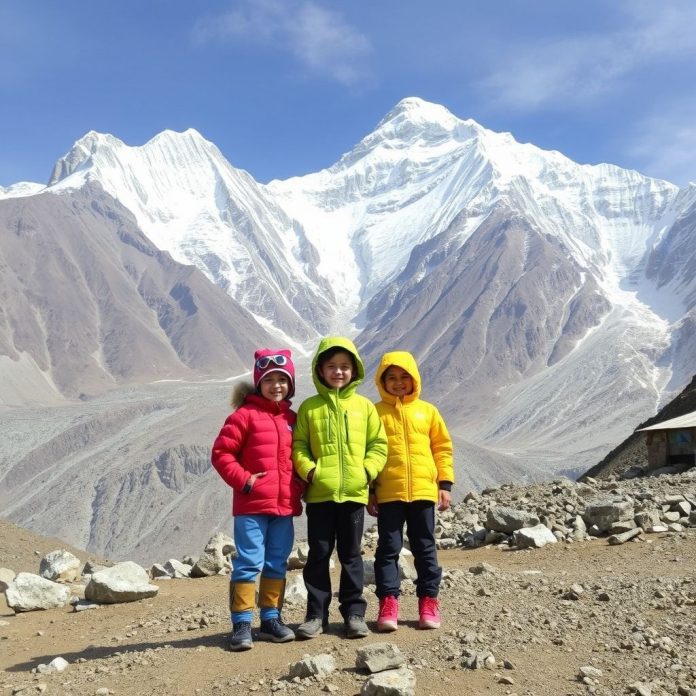Trekking to Everest Base Camp is a dream for many. But what if you’re planning to take your kids along? Sounds ambitious, maybe even a bit daunting—but it’s more common than you might think. Families from around the world are taking on the challenge, and many are finding that, with the right preparation, it’s a deeply rewarding experience for everyone involved.
Still, this isn’t your typical family holiday. You’re talking high altitude, unpredictable weather, and days of walking—often in challenging conditions. But for those who’ve done it, the sense of accomplishment, the family bonding, and the unforgettable views have made it worth every step.
Can Kids Really Do the EBC Trek?
The answer is yes—many kids have successfully trekked to Everest Base Camp. There are even records of toddlers reaching EBC, though such cases are rare and should be approached with extreme caution. In general, trekking with kids is possible as long as you’re flexible, cautious, and prepared.
However, it’s important to recognize the risks. Altitude sickness can affect anyone, regardless of age or fitness. The cold can be harsh, especially at higher altitudes. And long trekking days can be physically and emotionally draining. But none of that means it’s out of reach for families. Many have made the journey, and their stories offer helpful insights.
Real Families, Real Journeys: What the Trail Taught Them
Families who’ve trekked to Everest Base Camp with children often describe it as tough but deeply rewarding. Their experiences vary, but a few themes stand out:
1. Previous Experience Helps
Families with kids who had done prior Himalayan or altitude treks reported smoother journeys. Acclimatization was easier, and the kids knew what to expect in terms of terrain, daily routine, and cold weather.
2. Expect a Few Hiccups
Even with preparation, things can go sideways—like stomach upsets, fatigue, or altitude-related symptoms. One family used a horse for a day to help their child recover. Another opted for a helicopter return after reaching Base Camp due to exhaustion. Flexibility was key.
3. Make It Fun and Manageable
Parents found that turning the trek into a series of small adventures kept kids motivated. Milestones like suspension bridges, warm bakeries in Namche, or spotting yaks added excitement. Keeping things playful and goal-oriented made a big difference.
4. Gear and Food Choices Matter
Layered clothing, good boots, hydration packs, and kid-friendly snacks helped ease the journey. Families prioritized dal bhat, simple breakfasts like oatmeal, and lots of rest. Treats and hydration tablets were considered small essentials.
5. It’s Not Just a Trek—It’s a Life Lesson
Above all, families described the experience as transformational. Children walked away with a new sense of accomplishment, resilience, and appreciation for nature—and parents cherished the time spent away from screens, distractions, and everyday routines.
Tips for Trekking with Children
Gear & Clothing
-
Proper layering is key. Merino wool base layers, insulating mid-layers, and windproof outer shells help regulate body temperature across varied altitudes.
-
Warm accessories like gloves, hats, and buffs are a must, especially during early mornings and late evenings.
-
Quality hiking boots paired with moisture-wicking socks can help prevent blisters and fatigue.
Food & Hydration
-
Dal Bhat is the go-to meal—it’s warm, healthy, and often comes with unlimited servings.
-
Carry electrolyte powders and hydration tablets to prevent dehydration, which sets in more easily at altitude.
-
Snack planning matters—treats like Snickers or ramen are great motivation for kids but become pricey at higher elevations. Stock up early in Namche Bazaar.
Acclimatization & Itinerary
-
Build in buffer days. Kids may need extra rest or shorter walking distances.
-
Avoid pushing too far too fast. Altitude sickness can appear without warning, and children may not recognize or communicate the symptoms clearly.
-
Consider breaking up long days, especially on the return leg. For example, rather than going straight from Namche to Lukla in a single day, split it into two.
A Mindful Approach to Trekking with Kids
More than anything, trekking with children requires patience and flexibility. Kids experience the trek differently—they may find joy in the little things like crossing a bridge, meeting a yak, or sipping hot chocolate at a teahouse. Parents who’ve done the trek with their children often speak of how much they learned along the way—not just about the trail, but about resilience, teamwork, and the joy of slowing down.
It’s not always about reaching Base Camp. Sometimes, the journey itself becomes the destination.
Considerations & Concerns
While many families have had successful experiences, not everyone agrees on whether it’s appropriate. Some trekkers believe young children shouldn’t be taken to such high altitudes, citing safety risks and the harsh conditions. Concerns about altitude sickness, lack of medical infrastructure, and the physical toll of the trek are valid—and should be taken seriously.
There are also strong opinions about setting a good example in the mountains. The trek is difficult, and accidents or illnesses do happen. Responsible trekking means recognizing limits and making decisions based on the health and well-being of the whole group—not ego or external pressure.
Final Thoughts
Everest Base Camp with kids isn’t just a bucket list item—it’s an experience that can shape a child’s confidence, curiosity, and connection to nature. With the right support, thoughtful pacing, and attention to safety, it can be an extraordinary adventure that brings families closer together.
So if you’re planning the journey, pack wisely, listen closely to your children’s cues, and embrace the adventure—one step at a time.
Want more trail-tested tips and community stories?
Check out trekheaven.com — your friendly, no-BS guide to all things trekking in Nepal.

